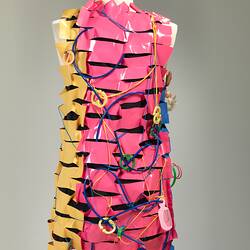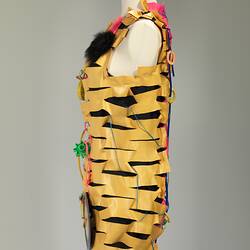Summary
Original version of the iconic 'Je Suis Mod' dress designed and made Melbourne by Jenny Bannister in 1978. Jenny wore this dress with pink high heeled shoes.
Later versions of the dress, which incorporated a conical bra, are held by the Powerhouse Museum in Sydney and the National Gallery of Victoria.
In 2005, a model wore this to illustrate a newspaper article in The Age newspaper, entitled 'Staying Afloat', which looked at the challenges Jenny's business was facing at the time.
From the beginning, Jenny incorporated other people's junk into her unique designs. Nothing symbolises this better than the fantastic plastic explosion of her iconic 'Je Suis Mod' dress. The result was an outfit perfect for a person as adventurous and extroverted as the creator herself.
It is part of the archives of Jenny Bannister, documenting her fashion design educational and vocational life, from the late 1960s until 2009.
Physical Description
Short sleeveless mod-style dress made from PVC plastic, mixed media, and cotton. Blue and yellow PVC material, that has been slashed horizontally, forms the front of the dress, with blue PVC sewn to the proper right and yellow PVC sewn to proper left of dress creating a split colour effect. Hot pink PVC material, that has been slashed horizontally, forms the back of the dress and is sewn to a section of the yellow PVC that wraps around the proper left side of dress. The PVC dress is supported underneath with a black cotton sleeveless shift dress that forms the underlying structure of the dress. Attached to front of dress is a 7" black vinyl record sung by 'Plastic Betrand'; the top half of a Barbie doll; plastic doll hairbrushes and fur; part of a plastic red lipstick; plastic wheels and circles in various shapes and colours; and plastic S-shape hooks. These objects are attached to the front and back with fluorescent coloured plastic string and tubing that runs the length of the dress. Medium-sized safety pins have also been used either to secure tubing to the dress or as a decorative element at the hem. The hem has been cut into points. Designer label sewn to front of dress at proper left of hem.
Significance
The Jenny Bannister archive is of national significance, and is arguably the most important fashion design, manufacture and retailing archive still in existence. It documents the career of one of Australia's most significant designers and business women, who kept a thriving company going for almost 40 years, long after her contemporaries had retired or gone bankrupt.
No other collection documents this significant period in Australian fashion and clothing manufacturing so completely and succinctly; from the rise of an independent fashion industry in the 1960s and 70s, complimented by a strong local manufacturing sector, to the moving offshore of most of the manufacture as costs rosed to the eventual bankruptcy and closure of many local labels due to an increased overseas retail presence and rise of online consumerism.
Its importance was recognised by the National Library of Australia, who collected the bulk of her business and manufacture archival material, including 100 of patterns. It was only the second such collection to enter the institution, after that of prominent Sydney designer Linda Jackson.
She was the master of creativity and diversity, able to capture numerous markets, producing the most outlandish and artistic garments as well as highly commercial clothing. as renowned fashion historian and academic Professor Robyn Healy wrote 'Art Clothes, body sculpture, craft, theatrical costume, party clothes or serious fashion - Jenny Bannister's work transcends categorization. Like a New Age traveller, she explores the extraordinary, the primitive and the futuristic, to create garments for for kings, the Mardi Gras of the hip crowd'.
More Information
-
Collection Names
-
Collecting Areas
-
Designer
Jenny Bannister, Melbourne, Greater Melbourne, Victoria, Australia, 1978
-
User
-
Inscriptions
Black ribbon label with pale grey embroidered signature: 'Jenny Bannister for chai'.
-
Classification
-
Category
-
Discipline
-
Type of item
-
Overall Dimensions
450 mm (Width), 850 mm (Height)
Measured flat: Bust circum. 740; Waist circum. 700; Hip circum. 800; Hem Circum. 800; Shoulder to waist 450; Shoulder to Hip 620;
-
Conservation
450 mm (Width), 350 mm (Depth), 850 mm (Height)
For exhibition
-
Keywords
Clothing, Fashion, Fashion Design, Fashion Industry, Women's Clothing, Innovation & Design, Australian Fashion Industry, Fashion, Fashion Design, Fashion Designers, Fashion Industry, Innovation & Design, Retailing, Clothing, Women's Clothing, Textiles




